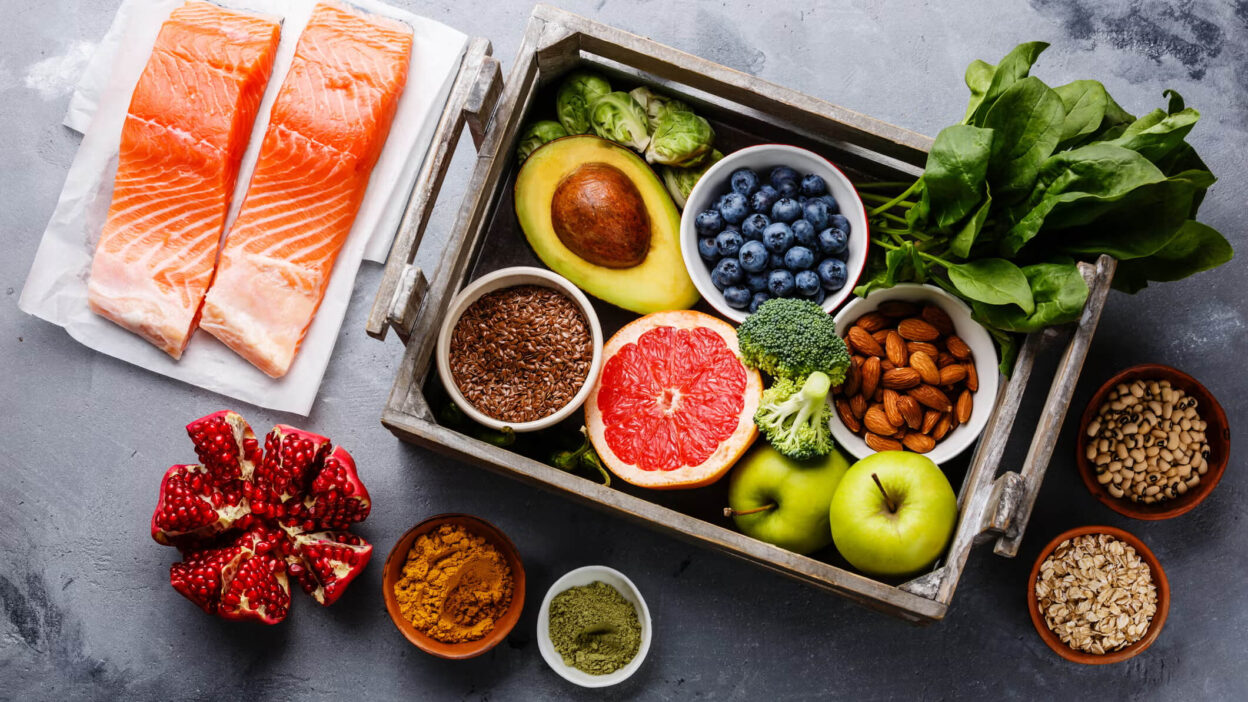What you eat directly affects how quickly glucose (sugar) enters your bloodstream and how well your body handles it. Choosing foods high in fiber, protein, healthy fats and with a low glycemic impact helps prevent big spikes and crashes in blood sugar, a core strategy for preventing and managing type 2 diabetes. Healthy eating is recommended as a cornerstone of diabetes prevention and care by leading health bodies.
How these foods help (short science)
Foods that regulate blood sugar work in three main ways:
- Slow digestion and absorption (soluble fiber forms a gel that delays glucose entry). According CDC
- Provide protein and healthy fats that blunt post-meal glucose rises and increase satiety.
- Have a low glycemic index (GI) so they release glucose into the blood more slowly. Choosing low-GI carbs lowers the speed and height of blood sugar spikes.
The six best foods (what to eat, why they help, and Nigeria-friendly tips)
1) Leafy green vegetables (spinach, ugu, bitter leaf, kale)
Why: Leafy greens are very low in available carbs but high in fiber, vitamins and magnesium; nutrients linked to better insulin sensitivity. They add bulk to your plate without raising blood glucose.
How to use it in Nigeria: Add sautéed ugu or spinach to soups and stews, include a side of steamed bitter leaf or fresh salad with your swallow. Aim for at least 1 – 2 cups of leafy greens daily.
2) Whole grains & oats (millet, sorghum, brown rice, rolled oats)
Why: Whole grains contain fibre (including soluble β-glucan in oats) and have lower GI than refined grains, they slow glucose absorption and improve fasting blood sugar and cholesterol.
Nigeria swaps & tips: Choose brown rice, whole-grain tuwo (millet/sorghum) where available, or start the day with oats instead of sweetened cereals. Watch portions, even whole grains contain carbs, so pair with protein/veg.
3) Legumes (beans, lentils, chickpeas)
Why: Beans/pulses are rich in soluble fiber and plant protein; they lower post-meal blood glucose and support long-term glycaemic control. Studies show regular legumes improve HbA1c and fasting glucose. As mentioned by CDC
Nigeria tip: Ewa (beans), moi moi, akara (in moderation) and stewed lentils make excellent, affordable staples. Combine with vegetables to make balanced meals.
4) Nuts & seeds (walnuts, almonds, flaxseed)
Why: Nuts provide healthy mono- and polyunsaturated fats, fiber and some protein, these slow digestion and can improve insulin sensitivity and heart health. Regular nut consumption is linked to better glucose control when used instead of refined snacks.
How to eat: A small handful (about 20 – 30g) as a snack or sprinkled onto porridges/salads. For seeds, add ground flaxseed to smoothies or pap for extra fibre and omega-3 benefits.
5) Fatty fish (salmon, mackerel, sardines)
Why: Fatty fish deliver omega-3 fats that support heart health, critically important because people with high blood sugar have higher cardiovascular risk. While fish doesn’t directly lower glucose, improving heart and metabolic health is part of comprehensive diabetes care.
Nigeria tip: Small oily fish (sardinella), mackerel and fresh local fish are excellent choices; grill, stew or bake with tomatoes and spices instead of frying.
6) Berries & low-GI fruits (blueberries, strawberries, apples)
Why: Berries are high in fiber and antioxidants and have a relatively low glycemic impact compared with many tropical juices or sweet snacks. Whole fruit provides fiber that slows sugar absorption. Learn more from Harvard Health
How to enjoy: Choose whole fruit over fruit juices. Have a small bowl of berries or a chopped apple with nut butter for balanced snacks.
Practical plate rules & portion tips
- Half your plate non-starchy vegetables (leafy greens, peppers, tomatoes). As mentioned by Diabetes Food Hub.
- A quarter lean protein (fish, beans, lean meat).
- A quarter whole grains or starchy vegetables (brown rice, millet, sweet potato); control portions to limit carbohydrate load.
- Snack smart: nuts, a small fruit, or Greek yoghurt (unsweetened) instead of sweets.
- Avoid sugary drinks and refined snacks: liquid sugars spike blood glucose rapidly. According to World Health Organization
Realistic meal examples (Nigeria-friendly)
- Breakfast: Oats cooked with water/milk, topped with chopped nuts and berries.
- Lunch: Brown rice + stewed veg + grilled mackerel + side salad (ugwu).
- Snack: Small handful of groundnuts or almonds and an apple.
- Dinner: Ewa (beans) + vegetable soup + small portion of tuwo (sorghum).
Evidence & guidance from health authorities
- WHO and CDC recommend healthy diets, fibre-rich foods and whole grains as part of diabetes prevention and management. These dietary patterns reduce risk and help control blood glucose over time.
- The ADA highlights vegetables, legumes, whole grains and healthy fats as “superstar” foods for people managing blood sugar.
Quick cautions & when to see a clinician
- Even “good” carbs raise blood sugar; portion control and pairing with protein/fat matters. Use a glucometer if you’re monitoring glucose responses to new foods.
- People on glucose-lowering medications (especially insulin or sulfonylureas) should check with their clinician before making big diet changes, some foods and weight loss can require medication adjustments.
- If you have diabetes or prediabetes, work with a dietitian or clinician to personalise targets and meal plans.
Bottom line
Six types of foods – leafy greens, whole grains/oats, legumes, nuts & seeds, fatty fish, and berries/low-GI fruit; consistently help steady blood sugar when used as part of a balanced eating pattern. Combine these choices with portion control, regular activity and routine checks to prevent spikes, support metabolic health and reduce diabetes risk. For Nigerians, affordable local options (millet, sorghum, ewa, small oily fish, and local leafy greens) make these strategies realistic and culturally appropriate.




